Chinese Name: 解放碑 Pronunciation: Jiěfàng Bēi
Building Time: 1947
Suggested Visiting Hours:1-3 Hours
Area: About 24,000 square meters
Address: 177 Minzu Road, Yuzhong District, Chongqing City, China
Best Visiting Season: Spring and Autumn (March to May, September to November)
Popular Activities: People walk along Jiefangbei Pedestrian Street and enjoy the local food and shopping.
Function: It is the spiritual symbol of the victory of the Anti-Japanese War, the only monument to commemorate the victory of the Anti-Japanese War, and a witness of Chongqing’s Liberation history. Now it has become a famous shopping district.
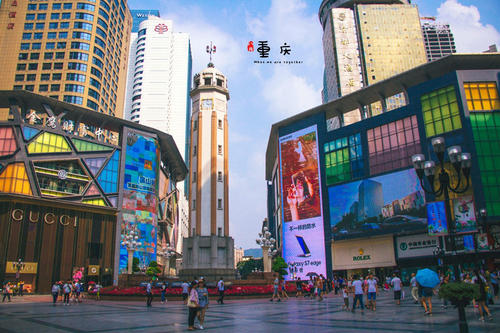
Jiefangbei Square with a total area of 24,000 square meters and a length of 400 meters from east to west and 300 meters from north to south is currently the most bustling commercial pedestrian street in southwest China. There are 2,000 commercial outlets of various sizes in the square.
The landmark Jiefangbei (the Liberation Monument), located in the center of the square, is the spiritual symbol of the victory of the Anti-Japanese War, the only monument to commemorate the victory of the Anti-Japanese War, and it is also one of the landmark buildings of Chongqing. With an exclusive historical extension, it wins the admiration of people and has a special influence at home and abroad.
In October 1946, a new monument was built at the original site of the “Spiritual Fortress” which was first erected on the anniversary of the death of Mr. Sun Yat-sen. The main body of the monument was built in August 1947 and completed in October of the same year, with the inscription “monument for the victory of the Anti-Japanese War”. On the monument, there is still a letter written by US President Roosevelt to the people of Chongqing during the victory of World War II.
In November 1949, the Chinese people’s Liberation Army conquered Chongqing. Liu Bocheng, the chairman of the Southwest Military and Political Commission, re-inscribed it as “monument of Chongqing People’s Liberation”, and recorded the military and civilian contributions to the bloody struggle of the whole country.
Nowadays, Jiefangbei Square is not only a historical architectural scenic spot but also forms a business economic circle. With rapid development, it undertakes the dual functions of business and commerce and is the core area of the Central Business District (CBD) of Chongqing.
In May 1950, the Southwest Department Store was established at Jiefangbei Square, marking the establishment of the Chongqing Department Store.
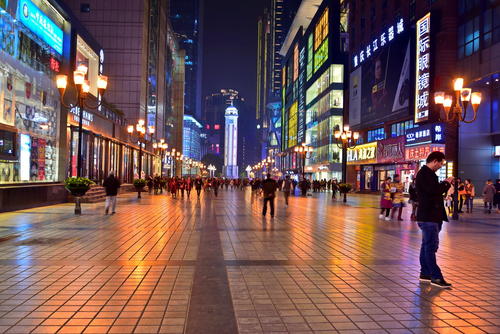
In 1982, the Huixian Tower was completed. Together with the first floor and the roof garden, the total number of floors reached 15. The height of the building was 54 meters, equivalent to the height of two Liberation Monument, and it was the tallest building in Chongqing at that time.
In 1997, Chongqing Yuzhong District Government invested 30 million yuan to transform the area around Jiefangbei (including Minquan Road, Minzu Road and Zourong Road) into Jiefangbei Central Shopping Square, the first commercial pedestrian street in southwestern China.
From 2000 to 2001, Yuzhong District Government invested 16 million yuan to expand the Jiefangbei Central Shopping Square to the middle section of Bayi Road and the Minzu Road extension.
In July 2003, the Chongqing Municipal Government approved the master plan of Chongqing CBD, which identified the Jiefangbei business district as the core of Chongqing CBD, and assumed the dual functions of commerce and trade.
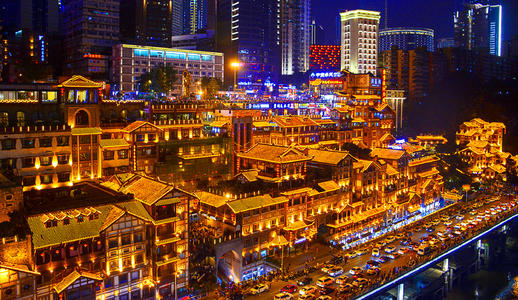
Located in the heart of the Jiefangbei business center,it is also the riverside area where the Yangtze River and Jialing River intersect. It is a tourist area with the functions of sightseeing, leisure, and vacation. In 2006, it was built with a total investment of 385 million yuan from the Chongqing Municipal Government. The main scenic spots are composed of stilted buildings, antique commercial streets, and other landscapes. The total building area is 46,000 square meters. Hongya Cave is a key landscape project in Chongqing, which is also the witness of Chongqing’s history and culture and the symbol of Chongqing’s urban spirit.
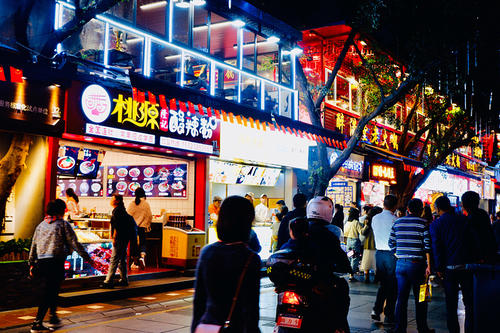
Bayilu Food Street, gathering hundreds of Chongqing delicacies, is the most popular food street in the main urban area of Chongqing, and also is the earliest food street in Jiefangbei business center. You can enjoy a variety of local cuisine. There are also sculptures created from the scenes of the food street, which are the earliest urban sculpture works appearing in the commercial pedestrian street in Chongqing.
Chongqing noodles are also the most common and popular local delicacies. The soup is fresh and fragrant, and the noodles are full of vitality. Hot and sour noodles are also one of the must-eat delicacies in Chongqing. The taste is sour and spicy enough to be authentic.
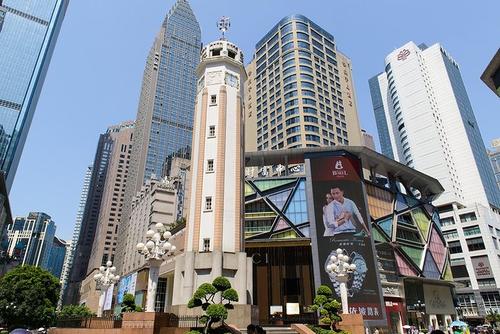
The People’s Liberation Monument, referred to as the Liberation Monument, began to be built on October 31, 1946 and was completed in August 1947. The monument is facing north, with an octahedral column and reinforced concrete structure; the total height of the monument is 27.5 meters, with a side length of 2.55 meters. The monument has eight layers with a spiral ladder to the top of the monument inside, and the four sides of the monuments are equipped with chime clocks. The monument is surrounded by a flower garden, with a total area of 62 square meters.
Take bus 462, G01, T001, T041, T480, K01, and get off at Jiefangbei Station.
Take bus 465,466, and get off at Linjiangmen Station.
Take bus 0492 and get off at Jiaochangkou Station.
Take Line 2 and get off at Linjiangmen Station.
Take Line 1 or Line 6, get off at Xiaoshizi Station and walk 500 meters to get there.
Chinese: 请带我去解放碑。English: Please take me to Jiefangbei Square.
If you go to Jiefangbei Square from Chongqing Jiangbei International Airport, it takes about 45 minutes (about 65 yuan).
If you go to Jiefangbei Square from Chongqingbei Railway Station, it takes about 30 minutes (about 40 yuan).
